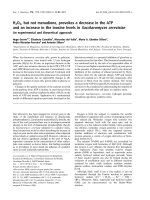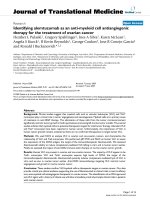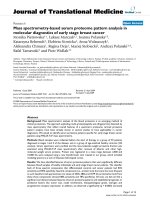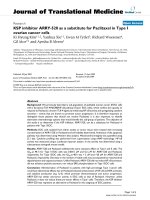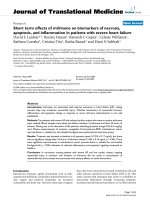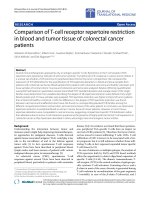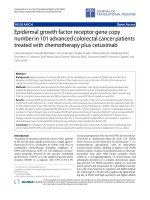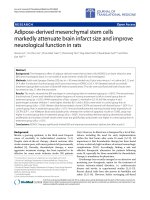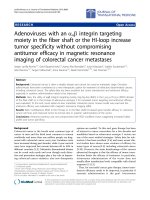báo cáo hóa học: " Lipopolysaccharide modulates astrocytic S100B secretion: a study in cerebrospinal fluid and astrocyte cultures from rats" pdf
Bạn đang xem bản rút gọn của tài liệu. Xem và tải ngay bản đầy đủ của tài liệu tại đây (819.55 KB, 11 trang )
RESEARCH Open Access
Lipopolysaccharide modulates astrocytic S100B
secretion: a study in cerebrospinal fluid and
astrocyte cultures from rats
Maria Cristina Guerra
†
, Lucas S Tortorelli
†
, Fabiana Galland, Carollina Da Ré, Elisa Negri, Douglas S Engelke,
Letícia Rodrigues, Marina C Leite
*
and Carlos-Alberto Gonçalves
Abstract
Background: Inflammatory responses in brain are primarily mediated by microglia, but growing evidence suggests
a crucial importance of astrocytes. S100B, a calcium-binding protein secreted by astrocytes, has properties of a
neurotrophic or an inflammatory cytokine. However, it is not known whether primary signals occurring during
induction of an inflammatory response (e.g. lipopolysaccharide, LPS) directly modulate S100B.
Methods: In this work, we evaluated whether S100B levels in cerebrospinal fluid (CSF) and serum of Wistar rats are
affected by LPS administered by intraperitoneal (IP) or intracerebroventricular (ICV) injection, as well as whether
primary astrocyte cultures respond directly to lipopolysaccharide.
Results: Our data suggest that S100B secretion in brain tissue is stimulated rapidly and persistently (for at least
24 h) by ICV LPS administration. This increase in CSF S100B was transient when LPS was IP administered. In
contrast to these S100B results, we observed an increase in in TNFa levels in serum, but not in CSF, after IP
administration of LPS. In isolated astrocytes and in acute hippocampal slices, we observed a direct stimulation of
S100B secretion by LPS at a concentration of 10 μg/mL. An involvement of TLR4 was confirmed by use of specific
inhibitors. However, lower levels of LPS in astrocyte cultures were able to induce a decrease in S100B secretion
after 24 h, without significant change in intracellular content of S100B. In addition, after 24 h exposure to LPS, we
observed a decrease in astrocytic glutathione and an increase in astrocytic glial fibrillary acidic protein.
Conclusions: Together, these data contribute to the understanding of the effects of LPS on astrocytes, particularly
on S100B secretion, and help us to interpret cerebrospinal fluid and serum changes for this protein in
neuroinflammatory diseases. Moreover, non-brain S100B-expressing tissues may be differentially regulated, since
LPS administration did not lead to increased serum levels of S100B.
Keywords: astrocyte, GFAP, glutath ione, LPS, TLR4, S100B
Background
S100B is a small very soluble calcium-binding protein
that is highly expressed and secreted by astrocytes in
the central nervous system (see [1] for a review). This
protein has many putative intracellular targets (e.g. glial
fibrillary acidic protein, GFAP) and, like other protein
members of the S100 family, is i nvolved in regulation of
the c ytoskeleton and the cell cycle. Moreover, extracel-
lular S100B at nanomolar levels in in vitro assays has
trophic effects on astrocytes, neurons and microglia.
Many modulators of S100B secretion have been
described in astrocyte preparations, such as forskolin,
lyso-phosphatidic acid [2], fluoxetin [3] and kain ate [4].
S100B secretion is also affected by metabolic stress con-
ditions such as elevated concentrations of glutamate [5],
glucose [6] and ammonium [7]. Other cells in the brain
(e.g. oligodendrocytes [8]) and outside (e.g. adipocytes
[9]) also express this protein, but whether S100B is
* Correspondence:
† Contributed equally
Departamento de Bioquímica, Instituto de Ciências Básicas da Saúde,
Universidade Federal do Rio Grande do Sul, Ramiro Barcelos, 2600- Anexo,
90035-003, Porto Alegre, Brazil
Guerra et al. Journal of Neuroinflammation 2011, 8:128
/>JOURNAL OF
NEUROINFLAMMATION
© 2011 Guerra et al; licensee BioMed Central Ltd. This is an Open Access article distributed under the terms of the Creative Commons
Attribution License ( which permits unrestricted use, distribution, and reproduction in
any medium, provided the original work is properly cited.
secreted by these cells and which secretagogues are
involved remain to be better characterized.
S100B has been proposed as a marker of astroglial
activation in brain disorders, and changes in its cere-
brospinal fluid and/or serum content have b een asso-
ciated with various neurological and psychiatric diseases
[10,11]. Such disorders commonly have an important
inflammatory component, in which S100B has often
been thought of as a cytokine. Recently, we demon-
stratedthatIL-1b modulates S100B secretion in astro-
cyte cultures and hippocampal slices [12]. Moreover
there is evidence that S100B mo dulates and is modu-
lated b y pro-inflammatory cytokines [13-15]. However,
we do not know if primary signals in the induction of
inflammatory responses (e.g. LPS) directly modulate
S100B.
Astrocytes are the most abundant glial cells in the brain,
where they play key roles in neurotransmitter metabolism,
antioxidant defense and regulation of extracellular concen-
tration of potassium [16]. GFAP, as mentioned above, is a
specific marker of astrocytes and, frequently, its elevation
is a strong sign of astrogliosis, which occurs in several con-
ditions involving brain injury [17].
LPS, a component of the cell wall of gram-negative
bacteria, has been widely used experimentally to stimulate
inflammatory responses, including in the central nervou s
system (e.g. [18]). Inflammatory response in the brain is pri-
marily mediated by microglia, but growing evidence sug-
gests a crucial importance of astrocytes as well [19]. Like
microglia, these cells have a toll-like receptor type
4 (TLR4), which belongs to TLR family receptors in the
vertebrate immune system and specifically recognizes LPS
[20].
Recent studies have shown that astrocytes respond to
LPS, decreasing expression of proteins such as gap junc-
tion proteins [21], and increasing expression of others
such as GFAP and glutathione-S-transferase [22,23].
Interestingly, we have demonstrated that gap junction
inhibitors increase secretion of S1 00B from astrocy tes
and hippocampal slices [24].
Our working hypoth esis was that S100B is released by
astrocytes as a cytokine in response to LPS. In this
study, we evaluated whether S100B content in c ere-
brospinal f luid (CSF) and serum of rats is affected by
LPS administered by i ntraperitoneal or intra cerebroven-
tricular injection, as well as whether astrocyte cultures
and acute hippocampal slices respond directly to LPS.
In parallel, we investiga ted whether LPS affects the con-
tent of GFAP and glutathione in astrocyte cultures, as
indices of astr ogliosis (GFAP) and antioxida nt defense
(based on capacity for synthesis and release of glu-
tathione). Moreover, we mea sured the profile of secre-
tion of TNFa, a cytokine that is well-known to respond
to LPS.
Methods
Materials
Poly-L-lysine, antibody anti-S100B (SH-B1), methylthiazo-
lyldiphen yl-tetrazolium bromide (MTT), neutral red, and
lipopolysaccharides from Escherichia coli (LPS) 055:B5
were purchased from Sigma [St. Louis, USA]. Fetal calf
serum (FCS), Dulbecco’ s modifi ed Eagle’ smedium
(DMEM) and other materials for cell culture were pur-
chased from Gibco [Carlsbad, USA]. Polyclonal anti-S100B
and anti-rabbit peroxidase linked were purchased from
DAKO [São Paulo, Brazil] and GE [Little Chalfont United
Kingdom], respectively. Inhibitors for TLR4 (CLI-095 and
OxPAPC) were f rom InVivoGen [San Diego, USA].
Surgical procedure for intracerebroventricular (ICV) LPS
infusion
Procedures were carried out in accordance with the NIH
GuidefortheCareandUseofLaboratoryAnimalsand
were approved by the local authorities. Adult Wistar rats
(90 days old) were used. For ventricular access, the ani-
mals were anesthetized with ketamine/xylazine (75 and 10
mg/Kg, respectively, i.p.) and placed in a stereotaxic appa-
ratus. A midline saggital incision was made in the scalp
and one burr hole was drilled in the skull over both ventri-
cles. The following coordinates were used: 0.9 mm poster-
ior to bregma; 1.5 mm lateral to saggital suture; 3.6 mm
beneath the brain surface [25]. The rats received 5 μL
ICV/side of LPS 2.5 ug/μL or phosphate-buffered saline
(control). After the surgical procedure, rats were kept in a
stereotactic holder for 30 min or 24 h and CSF was
obtained by puncture of the cisterna magna using an insu-
lin syringe. A maximum volume of 30 μL was collected
over a 3-min per iod to minimize risk of brain stem
damage. The blood samples were collected by careful
intracardiac puncture, using a 5-mL non-heparinized syr-
inge to obtain 3 mL of blood. Blood samples were incu-
batedatroomtemperature(25°C)for5minand
centrifuged at 3200 rpm for 5 min to obtain serum. Cere-
brospinal fluid and serum samples were frozen (-70°C)
until used for S100B or TNFa analysis.
Intraperitoneal (IP) LPS infusion
Wistar rats (90 days old) were used for intraperitoneal
injection of 0.3 mL of LPS, 250 μg/Kg, or phosphate-buf-
fered saline (control). After 30 min or 24 h, the animals
were anesthetized with ketamine/xylazine (75 and 10 mg/
Kg, respectively, i.p.) and placed in a stereotaxic apparatus
for CSF punctur e. Blood samples were obtained by intra-
cardiac puncture, and the animals were killed by
decapitation.
Cell culture
Primary astrocyte cultures from Wistar rats were pre-
pared as previously described [26]. Procedures were
Guerra et al. Journal of Neuroinflammation 2011, 8:128
/>Page 2 of 11
carried out in accordance with the NIH Guide for the
Care and Use of Lab oratory Animals and were approved
by the local authorities. Briefly, cerebral cortices of new-
born Wistar rats (1-2 days old) were removed and
mechanically dissociated in Ca
2+
-andMg
2+
-free
balanced salt solution, pH 7.4, containing (in mM): 137
NaCl; 5.36 KCl; 0.27 Na
2
HPO
4
;1.1KH
2
PO
4
and 6.1 glu-
cose. The cortices were cleaned of meninges and
mechanically dissociated by sequential passage through a
Pasteur pipette. After centrifugation at 1400 RPM for
5 min the pellet was resuspended in DMEM (pH 7.6)
supplemented with 8.39 mM HEPES, 23.8 mM NaHCO
3
,
0.1% amphotericin, 0.032% gentamicin and 10% fetal calf
serum (FCS). Cultures were maintained in DMEM con-
taining 10% FCS in 5% CO
2
/95% air at 37°C, allowed to
grow to confluence, and used at 15 days in vitro.
Hippocampal slices
Hippocampal slices were prepared as previously
described [27]. Procedures were ca rried out in accor-
dance with the NIH Guide for the Care and Use of
Laboratory Animals and were approved by the local
authorities. Thirty-day old Wistar rats were killed by
decapitation and the brains were removed and placed in
cold saline medium with the following composition (in
mM): 120 NaCl; 2 KCl; 1 CaCl
2
;1MgSO
4
; 25 HEPES;
1KH
2
PO
4
, and 10 glucose, adjusted to pH 7.4 and pre-
viously aerated with O
2
. T he hippocampi were dissected
and transverse slices of 0.3 mm were obtained using a
McIlwain Tissue Chopper. Slices were then transferred
immediately into 24-well culture plates, each well con-
taining 0.3 ml of physiological medium a nd only one
slice. The medium was changed every 15 min with fresh
saline medium at room temperature (maintained at
25°C). Following a 120-min equilibration period, the
medium was removed and replaced with physiological
saline with or without LPS for 60 min at 30°C on a
warm plate. Afterwards, media were collected and stored
at -70°C until used for assay of S100B or TNFa.
S100B measurement
S100B was measured by ELISA, as previously d escribed
[28]. Briefly, 50 μlofsampleplus50μl of Tris buffer
were incubated for 2 h on a microtiter plate previously
coated with monoclonal anti-S100B. Polyclonal anti-S100
was incubated for 30 min and then peroxidase-conju-
gated anti-rabbit antibody was added for a further
30 min. Color reaction with o-phe nylenediami ne was
measured at 492 nm. The standard S100B curve ranged
from 0.002 to 1 ng/ml.
GFAP measurement
ELISA for GFAP was carried out, as p reviously described
[29], by coating microtiter plates with 100 μL samples for
24 h at 4°C. Incubation with a polyclonal anti-GFAP
from rabbit for 1 h was followed by incubation with a
secondary antibody conjugated w ith peroxidase for 1 h,
at room temperature. A colorimetric reaction with o-phe-
nylenediamine was measured at 492 nm. The standard
human GFAP (from Calbiochem) curve ranged from 0.1
to 5 ng/mL.
MTT reduction assay
Cells were treated with 50 μg/mL Methylthiazolyldiphe-
nyl-tetrazolium bromide (MTT) f or 30 min in 5% CO
2
/
95% air at 37°C. Afterwards, the media was removed and
MTT crystals were dissolved in DMSO. Absorbance values
were measured at 560 and 650 nm. T he reduction of MTT
was calculated as (absorbance at 560 nm) - (absorbance at
650 n m ).
Neutral red uptake
Neutral red incorporation was carried out as previously
described [24] with modifications. Cells were treated with
50 μg/mL neutral red (NR) for 30 min in 5% CO
2
/95% air
at 37°C. Afterwards, the cells were rinsed twice with PBS
for 5 min each and NR dye taken up by viable cells was
extracted with 500 μL of acetic acid/ethanol/water (1/50/
49). Absorbance values were measured at 560 nm.
Lactate dehydrogenase (LDH) assay
Lactate dehydrogenase assay was carried out in 50 μLof
extracellular medium, using a commercial colorimetric
assay from Doles (Goiânia, Brazil).
Glutathione content
Glutathione content was determined as previously
described [30]. Briefly, hippocampal slices or astrocyte cul-
tures were homogenized in sodium phosphate b uffer
(0.1 M, pH 8.0) containing 5 mM EDTA and protein was
precipitated with 1.7% meta-phosphoric acid. Supernatant
was assayed with o-phthaldialdehyde (1 mg/mL of metha-
nol) at room temperature for 15 min. Fluorescence was
measured using excitation and emission wavelengths of
350 and 420 nm, respectively. A calibration curve was per-
formed with standard glutathione solutions (0-500 μM).
Tumor necrosis factor a (TNFa) measurement
This assay was carried out in 100 μLofCSF,serumor
extracellular medium, using a rat TNFa ELISA from
eBioscience (San Diego, USA).
Statistical analysis
Parametric data are reported as mean ± standard error
and were analyzed by Student’s t test (when two groups
were considered) or by one-way analysis of variance
(ANOVA) followed by Duncan’s test, in the SPSS-16.0.
Data from GFAP, S100B and TNFa measurements were
Guerra et al. Journal of Neuroinflammation 2011, 8:128
/>Page 3 of 11
log-transformed to satisfy the assumption of the statisti-
cal tests when necessary. Tests are specified in the
legends, with level of significance set at p < 0.05.
Results
LPS induces increases in S100B levels in cerebrospinal
fluid, but not in serum
Anesthetized adult rats received 10 μLICVof2.5μg/μ L
LPS or phosphate-buffered saline (control). CSF and
blood were collected at 30 min or 24 h after LPS admin-
istration. A significant increase in CSF S100B was
observed at 30 min (p = 0.009) and 24 h (p = 0.003)
(Figure 1A), without significant changes in S100B serum
content (p = 0.99, 30 min and p = 0.47, 24 h) (Figure 1B).
Interestingly, when rats received IP LPS (250 μg/Kg
body) they also exhibited an increase in CSF S100B
at 30 min (p = 0.007), but not at 24 h (p = 0.68) (Figure
1C),andagainnosignificantchangesinserumS100B
were observed when compared with controls that
rece ived phosphate-buffered saline (p = 0.28, 30 min and
p = 0.32, 24 h) (Figure 1D). Notice that, assuming a mean
body weight of rats of 0.3 Kg, the amount of LPS admi-
nistered IP and ICV was 75 and 25 μg, respectively.
LPS directly affects astrocytic S100B secretion, apparently
without changing the intracellular content of this protein
In order to investigate whether this effect was attributable
to a direct effect of LPS on astrocytes, we added different
concentrations of LPS (from 0.01 to 30 μg/mL) to primary
astrocy te cu ltures and extracellular S100B was measured
at 1 h (Figure 2A) and 24 h (Figure 2B). At 1 h, LPS (at
concentrations from 10 μg/mL upwards) increased S100B
secretion (p < 0.001, ANOVA). Conversely, at 24 h, LPS
caused a decrease in S100B secretion, even with LPS con-
centrations as low as 0.01 μg/mL (p < 0.001). Acute hippo-
campal slices were also exposed to LPS for 1 h (Figure 2C)
and a decrease in S100B secretion was observed at LPS
concentrations from 0.1 to 1 μg/mL (p < 0.001). However,
LPS at 10 μg/mL produced an increase in S100B secretion
(p < 0.001). In order to characterize whether the effect of
Figure 1 LPS induces increased levels of S100B in cerebrospinal fluid (CSF), but not in serum. Intracerebroventricular injection of LPS, or
saline solution, was carried out in adult Wistar rats under anaesthesia. After 30 min or 24 h, cerebrospinal fluid was collected by magna
puncture (A) and blood by intracardic puncture (B). The control group is represented by grey bars and the LPS-treated group is represented by
open bars. Each value is a mean (± standard error) from 5 rats per group. Intraperitoneal infusion of LPS, or saline solution, was carried out in
adult Wistar rats under anaesthesia. After 30 min or 24 h, CSF was collected by magna puncture (C) and blood by intracardic puncture (D). The
control group is represented by grey bars and the LPS-treated group is represented by open bars. Each value is a mean (± standard error) from
5 rats per group. * Significantly different from respective control (Student t test, p < 0.05).
Guerra et al. Journal of Neuroinflammation 2011, 8:128
/>Page 4 of 11
Figure 2 S100B secretio n is modified by LPS in astrocyte cultures and acute hippocampal slices. Rat cortical astrocytes were cultured in
DMEM containing 10% FCS. After confluence, the medium was replaced by DMEM without serum in the presence or absence of LPS (from 0.01
to 30 μg/mL). S100B was measured by ELISA at 1 h (A) and 24 h (B). Each value is a mean (± standard error) of at least 5 independent
experiments performed in triplicate. Means indicated by different letters are significantly different, assuming p < 0.05. (C) Adult Wistar rats were
killed by decapitation and 0.3 mm hippocampal slices were obtained using a McIlwain chopper. After a metabolic recovery period, hippocampal
slices were exposed to LPS (from 0.1 to 10 μg/mL) and the extracellular content of S100B measured by ELISA at 1 h. Each value is the mean (±
standard error) of at least 5 independent experiments performed in triplicate. Means indicated by different letters are significantly different (one
way ANOVA followed by Duncan’s test, with a significance level of p < 0.05).
Guerra et al. Journal of Neuroinflammation 2011, 8:128
/>Page 5 of 11
LPS is mediated by TLR4, we incubated astrocytes with
specific inhibitors for this receptor (Cli-095 and OxPAPC,
at 1 μMand30μg/mL, respectively). Both CLI-095
(Figure 3) and OxPAPC (data not s hown) abolished the
effect of LPS. It is important to mention that OxPAPC per
se increased S100B secretion and therefore it is difficult to
affirm that this inhibito r prevented the effect induced by
LPS.
After 24 h of exposure to LPS, we measured S100B
and GFAP content in lysed preparations of astrocyte
cultures (Figu re 4A and 4B, respectively). No s ignificant
changes were observed in S100B content (p = 0.85), but
interestingly an increase in GFAP content was observed
at all concentrations of LPS (p = 0.04).
LPS decreases glutathione content, but does not affect
cell viability and integrity
Another parameter analyzed to evaluate astroglial activity
was intracellular content of glutathione. After exposure of
astrocytes to LPS (at concentrations from 0.01 to 30 μg/
mL), we observed a decrease in intracellular content of
glutathione after 24 h (p = 0.011), but not at 1 h (p = 0.49)
(Figure 5A and 5B). Hippocampal slice preparations also
exhibited a decrease in glutathione content after LPS
exposure for 1 h (p = 0.015) (Figure 5C).
In order to detect a possible toxic effect of LPS in our
preparations, we evaluated their capacities for MTT reduc-
tion, neutral red incorporation and LDH release. No
changes in MTT reduction assay (p = 0.25) (Figure 6A) or
in neutral red assay (p = 0.37) (Figure 6B) were induced in
astrocyte c ultures exposed to LPS (from 0.01 to 30 μg/mL).
In addition, no changes in LDH release were seen (data
not shown). Similar assays were also carried out in slice
preparations confirming cell viability and integrity (data
not s hown).
LPS induces an increase in TNFa in serum, but not in CSF
Finally, we measured the response of the classic inflam-
matory cytokine, TNFa, to LPS in vivo to confirm the
activity of this compound and to compare this response
to that of S100B protein. In contrast to results for S100B,
at 30 min and 24 h after IP administ ration of LPS
(approximately 75 μg ) we observed an increase in TNFa
in serum (p = 0.04, 30 min and p = 0.04, 24 h), but not in
CSF (p = 0.15, 30 min and p = 0.34, 24 h) (Ta ble 1).
When LPS (25 μg) was administered ICV we found an
early and transient increase in TNFa in serum ( p <
0.001) (at 30 min) and a later increase in CSF (p = 0.006)
(at 24 h) (Table 2). In addition, we observed an increase
in LPS-induced TNFa release from astrocyte cultures at
Figure 3 The LPS-induced decrease in S100B secretion is
abolished by inhibition of TLR4. Rat cortical astrocytes were
cultured in DMEM containing 10% FCS. After confluence, the
medium was replaced by DMEM without serum in the presence or
absence of 0.1 μg/mL LPS and 1 μM CLI-095, an inhibitor of TLR4.
S100B was measured by ELISA at 24 h. Each value is a mean (±
standard error) of at least 5 independent experiments performed in
triplicate. Means indicated by different letters are significantly
different (one way ANOVA followed by Duncan’s test, with a
significance level of p < 0.05).
Figure 4 Intracellular GF AP content is modified by LPS without
change in intracellular S100B content in astrocytes. Rat cortical
astrocytes were cultured in DMEM containing 10% FCS. After
confluence, the medium was replaced by DMEM without serum in the
presence or absence of LPS (from 0.01 to 30 μg/mL). Cells were lysed
and intracellular contents of S100B (A) and GFAP (B) were measured
by ELISA. Each value is the mean (± standard error) of at least 5
independent experiments performed in triplicate. Means indicated by
different letters are significantly different (one way ANOVA followed by
Duncan’s test, with a significance level of p < 0.05).
Guerra et al. Journal of Neuroinflammation 2011, 8:128
/>Page 6 of 11
1, 6 and 24 h after exposure to LPS (Figure 7, p < 0.001).
We were not able to detect TNFa release in acute hippo-
campal slices.
Discussion
S100B has been proposed as a marker of brain injury
and its elevation in CS F has been interpreted as a signal
of astroglial acti vation [10,11]. Moreover, it has been
assumed t hat S100B from CSF easily crosses the blood
brain barrier and that a S100B increment in peripheral
blood is indicative o f brain injury. However, in some
Figure 5 GSH content is modified by LPS in astrocyte cultures
and hippocampal slices. Rat cortical astrocytes were cultured in
DMEM containing 10% FCS. After confluence, the medium was
replaced by DMEM without serum in the presence or absence of
LPS (from 0.01 to 30 μg/mL). Cells were lysed in 1 h (A) or 24 h (B)
and intracellular GSH content was measured. Each value represents
the mean (± standard error) of at least 5 independent experiments
performed in triplicate. Means indicated by different letters are
significantly different (one way ANOVA followed by Duncan’s test,
with a significance level of p < 0.05). (C) Adult Wistar rats were
killed by decapitation and 0.3 mm hippocampal slices were
obtained using a McIlwain chopper. After a metabolic recovery
period, hippocampal slices were exposed to LPS (from 0.1 to 10 μg/
mL) and intracellular content of S100B was measured by ELISA at 1
h. Each value is the mean (± standard error) of at least 5
independent experiments performed in triplicate. Means indicated
by different letters are significantly different (one way ANOVA
followed by Duncan’s test, with a significance level of p < 0.05).
Figure 6 LPS does not affect cell viability. Rat cortical astrocytes
were cultured in DMEM containing 10% FCS. Confluent astrocytes
were exposed to LPS (from 0.01 to 30 μg/mL), during 24 h. At the
end, cells were incubated with MTT (A) or neutral red (B). Each
value is the mean (± standard error) of at least 5 independent
experiments performed in triplicate. Statistical analysis was
performed by one way ANOVA.
Table 1 Serum and CSF TNF
a
levels after IP
administration of LPS in rats
Control LPS
a
P
Serum (30 min) 3.4 ± 1.0 192.1 ± 97.2 0.046*
Serum (24 h) 1.1 ± 0.4 2.6 ± 0.2 0.021*
CSF (30 min) 2.7 ± 1.0 1.1 ± 0.5 0.145
CSF (24 h) 8.3 ± 5.5 2.5 ± 1.0 0.34
Values are mean (pg/mL) ± standard error (n = 5). Statistical analysis was
performed using Student’s t test, * indicates p < 0.05;
a
250 μg/Kg.
Guerra et al. Journal of Neuroinflammation 2011, 8:128
/>Page 7 of 11
pathophysiological conditions other interpretations are
possible and, consequently, an intense debate has been
developed, mainly because there are extra-cerebral
sources of S100B [31].
Serum levels of S100B after exposure to LPS have
been measured in some studies. S100B protein blood
levels in fetal sheep were found to be significantly higher
1 h after LPS administration (intravenous [IV], 5 mg/Kg)
and to return to baseline between 12 and 72 h after
exposure [32]. S imilarly, in Sprague-Dawley rats, this
quantity of LPS is able to induce an increase in serum
S100B 5h later [33]. In our study, ICV (2.5 ng) or IP.
administration (0.25 mg/Kg) of LPS to Wistar rats did
not a lter serum S100B levels, measured 30 min and 24
h after exposure. This discrepancy could be due to the
different quantities of LPS employed, to its method of
administration, or to the type of animal. Importantly,
LPS (IV 2 ng/Kg), when given to humans, is not able to
induce significant changes in serum S100B at 1 h or 8 h
post treatment [34].
In addition to measuring serum S100B, we also evalu-
ated S100B levels in CSF, astrocyte cultures and acute
hippocampal slices of rats exposed to LPS. Astrocytes
are thought of as active cells in the immune response,
because they have receptors for this response (e.g TLR4)
and a re able to secrete cytokines [19,35]. We found an
increase in CSF S100B after LPS both for ICV (early
and persistent resp onse) and for IP administration (early
and t ransient response). Notice that LPS is potentially
able to cross the blood-brain barrier [36]. Clearly no
immediate increment in serum S100B occurred in either
condition. This suggests brain-specific, LPS-induced
release of S100B, i.e., peripheral immune cells stimulated
by LPS did not release or cause a detectable S100B
release from potential extra-cerebral sources of S100B
(e.g. adipocytes). In other words, these data suggest dif-
ferent LPS-sensitivities for S100B secretion in central
and peripheral S100B-expressing cells. Conversely, we
observed an immediate serum TNFa increase after LPS
administration by both ICV and IP routes. It has been
proposed that TNFa is able to mediate S100B secretion
in astrocytes [37]. However, under LPS stimulation, our
results regarding the profiles of increases in TNFa and
S100B in serum and CSF suggest independent responses
(Table 3).
Other aspects must be emphasized. The increase in CSF
S100B levels that we found was not accompanied or
Table 2 Serum and CSF TNF
a
after ICV administration of
LPS in rats
Control LPS
b
p
Serum (30 min) 0.7 ± 0.3 121.6 ± 40.0 0.001*
Serum (24 h) 1.1 ± 0.3 1.0 ± 0.3 0.945
CSF (30 min) 38.8 ± 9.8 75.1 ± 24.9 0.215
CSF (24 h) 1.7 ± 1.2 19.6 ± 4.5 0.006*
Values are mean (pg/mL) ± standard error (n = 5). Statistical analysis was
performed using Student’s t test, * indicates p < 0.05;
b
25 μg
Figure 7 TNFa secretion is modified by LPS in astrocyte
cultures. Rat cortical astrocytes were cultured in DMEM containing
10% FCS. After confluence, the medium was replaced by DMEM
without serum in the presence or absence of LPS (from 0.01 to 30
μg/mL). TNFa was measured by ELISA at 1 h (A) and 6 h (B). Each
value is a mean (± standard error) of at least 5 independent
experiments performed in triplicate. Means indicated by different
letters are significantly different (one way ANOVA followed by
Duncan’s test, with a significance level of p < 0.05).
Guerra et al. Journal of Neuroinflammation 2011, 8:128
/>Page 8 of 11
followed by an increase in serum S100B levels, at least in
measurements made at the evaluated times (30 min and
24 h after LPS). This increase in CSF S100B was rapid (i.e.
detected in 15 min) and lasting (for at least 24 h). Notice
that control animals for the experiments involving ICV
administration of LPS exhibited higher levels of CSF
S100B (Figure 1A) than did controls for IP administration
(Figure 1C), suggesting a response to the invasive
procedure.
Astrocytes in culture secreted S100B directly in response
to LPS (from 10 μg/mL upward) at 1h, but at 24 h a
decrease in secretion (dependent on LPS concentration)
was observed even at lower concentrations. This suggests
a biphasic response, i.e. an increase in S100B secretion, fol-
lowed by a decrease. This profile has been observed in
astrocyte cultures under other conditions, such as expo-
sure to beta-hydroxybutyrate [38]. This rapid and transient
stimulation of S100B secretion in astrocyte cultures was
also observed for the cytokine IL-1b,butwithouta
decrease at 24 h [12]. This finding could suggest that the
LPS effect is direct and independent of secondarily-
released IL-1b. Other studies have reported an increase in
cell content of S100B in C6 glioma cells after 24 h of expo-
sure to IL-1b [39] or no change in astrocyte cultures after
48 h [40] and a decrease in S100B content in cultured
astrocytes after 3 days of exposure to TNFa [37]. How-
ever, these studies did not measure S100B secretion ade-
quately and it is not possible to speculate about a
secondary effect of these two cytokines on S100B secretion
after long-term LPS exposure under the conditions used
here. Therefore, in agreement with our working hypoth-
esis, it appears that LPS is able to directly modulate S100B
secretion.
In addition, when we used acute hippocampal slices to
evaluate S100B secretion at 1 h, we also observed an
increase in S100B secretion with LPS at 10 μg/mL, but
conv ersely we observed a decrease in LPS at 0.1 or 1 μg/
mL. These preparations are complex from a cellular view,
i.e. in addition to astrocytes, they contain active microglia
and neurons, which makes interpretation of the control of
S100B release difficult. However, a similar result, obtained
in response to endothelin-1, has also been observed [24].
This compound, due to its blocking effect on gap junc-
tions, increases S100B secretion in astrocyte cultures in
the first hour, but after 6 hours decreases S100B secretion.
Similarly, in acute hippocampal slices, endothelin-1
decreases S100B secretion at 1 h. Potentially, both LPS
and endothelin-1 down-regulate gap junction proteins.
Although we have no doubt about the effects of LPS and
endothelin-1 on S100B secretion in acute hippocampal
slices, we have no explanation for this effect, when com-
paredtothatobservedinisolatedastrocytes,atthis
moment.
Secreted S100B is a very small part of total cell content
(less than 0.5% is found in the medium of astrocyte cul-
tures at 24 h) and changes in S100B secretion are not
necessarily accompanied by changes in the cell c ontent
[31]. In fact, in our experiments LPS changed S100B secre-
tion without affecting cell conte nt of this protein. On the
other hand, GFAP content was increased by all concentra-
tions of LPS used, indicating astroglial activation. This is
in agreement with previous reports about the effects of
LPS on astrocyte cultures [22,23]. This reinforces the idea
that GFAP and S100B have distinct regulatory mechan-
isms of expression and that astrogliosis (as assessed by
GFAP increment) can either be accompanied or not
accompanied by changes in cell S100B content [41].
Another interes ting aspect of our findi ngs is decreased
glutathione content after LPS exposure. The decrease in
glutathione content in astrocytes at 24 h (but not at 1 h)
is possibly associated with up-regulation of glutathione-
S-transferase, as observed very recently [22]. Part of the
decrease could involve an intense exportation of this pep-
tide, since it serves as an extracellular antioxidant, and
also provides substrates for neuronal synthesis of glu-
tathione[42].Inaddition,wealsofoundadecreasein
glutathione content in acute hippocampal slices exposed
to LPS.
In spite of this decrease in antioxidant defense , both
preparations exhibited excellent viability and integrity,
based on MTT reduction assays, neutral red incorpora-
tion and LDH release. These assays, performed in paral-
lel to assays for S1 00B measurements, allowed us to be
emphatic throughout the t ext about S100B secretion,
instead of S100B release.
Although S100B has cytokine-like actions (e.g. [43]),
some caution should be taken in the categorization of
S100B as a cytokine. In contrast to classical cytokines,
S100B is not produ ced exclusively for secretion; only a
ver y small part is exported. More recently, some authors
have suggested that S100B, like other members of the
S100 family, may act as an alarmin or damage-associ ated
molecular pattern (see [44] for a review). However,
Table 3 Qualitative comparison of TNFa and S100B levels
in serum and CSF after LPS administration
TNFa S100B
LPS IP Serum (30 min) ↑ –
Serum (24 h) ↑ –
CSF (30 min) – ↑
CSF (24 h) ––
LPS ICV Serum (30 min) ↑ –
Serum (24 h) ––
CSF (30 min) – ↑
CSF (24 h) ↑↑
↑ indicates a significant increase compared to control, with a significance level
of p < 0.05; – indicates no significant difference compared to control. See
Table 1, Table 2 and Figure 1 for details.
Guerra et al. Journal of Neuroinflammation 2011, 8:128
/>Page 9 of 11
independently of these conceptions, our data suggest that
S100B secretion is modulated by LPS. In fact, secretion
of S100B might be protective during the initial phase of
LPS challenge. In contrast, prolonged LPS treatment
results in a dose-dependent decrease in S100B secretion
from astrocytes. This indicates that one potential effect
of long-lasting exposure to LPS might be decreased
secretion of trophic factors from astrocytes.
It should be noted that some aspects of the effect of LPS
remain unclear. Firstly, is the effect of LPS mediated exclu-
sively by TLR-4 in astrocytes? We cannot rule out other
possibilities at this moment, since LPS could be acting on
other receptors (e.g. CD14 and LBP [45]. Secondly, it is
still not clear whether LPS can affect S100B secretion in
other S100-expressing cells. There are many extracerebral
S100B-expressing cells that affect serum S100B levels [46]
and these, apparently, were not mobilized under our con-
ditions of LPS stimulation. However, further studies must
investigate specific extracerebral sources of S100B. For
example, it is known that enteroglia respond to LPS by
increasing levels of S100B mRNA[47].Third,whether
gram-negative infectious agents could cause similar effects
on S100B secretion, mediated by LPS release, is not clear
at the moment. Interestingly, serum S100B was found to
be increased in patients with cerebral and extracerebral
infectious disease [48]. In that study, S100B elevation was
general ly higher in patients with cerebral infections tha n
in extracerebral infections. However, specific and chronic
effects of gram-negative bacteria on central and peripheral
S100B deserve further investigation.
Conclusions
Our data suggest that S100B secretion in brain tissue is
stimulated rapidly and persistently (at least for 24 h) by
ICV administration of LPS. Moreover, no changes were
observed in serum levels of this protein. This profile is
quite d ifferent from that of TNFa, a canonical inflam-
matory cytoki ne. In isolated astrocytes and acute hippo-
campal slices, we observed a direct stimulation of S100B
secretion by LPS at a concentration of 10 μg/mL,
mediated by TLR4. However, in astrocyte cultures,
lower levels of LPS were able to induce a decrease in
S100B secretion 24 h afterwards, without significant
changes in the intracellular content of S 100B. In addi-
tion,after24hofexposureofastrocytestoLPS,we
observed a decrease in glutathione and a n increase in
GFAP. Together, these data contribute to our under-
standing of the effect of LPS on astrocytes, particularly
on S100B secretion, and help us to interpret cerebrosp-
inal fluid and serum changes of this protein in neuroin-
flammatory diseases and brain disorders in general.
Moreover, S100B-expressing tissues may be differentially
regulated, since LPS did not lead to increases in serum
S100B.
Acknowledgements
This work was supported by the Conselho Nacional de Desenvolvimento
Científico e Tecnológico (CNPq), Coordenação de Aperfeiçoame nto de
Pessoal de Nível Superior (CAPES), FINEP/Rede IBN 01.06.0842-00 and INCT-
National Institute of Science and Technology for Excitotoxicity and
Neuroprotection. We would like to thank Ms. Gisele Souza for technical
support with cell culture.
Authors’ contributions
Conception and design of experiments: MCG, LST, MCL and CAG
Acquisition, analysis and interpretation of data: MCG, LST, MCL, FG, CDR, EN,
DSE and LR
Writing and/or critical review of article: MCG, LST, MCL and CAG
All authors have read and approved the final version of the manuscript.
Competing interests
The authors declare that they have no competing interests.
Received: 2 December 2010 Accepted: 4 October 2011
Published: 4 October 2011
References
1. Donato R, Sorci G, Riuzzi F, Arcuri C, Bianchi R, Brozzi F, Tubaro C,
Giambanco I: S100B’s double life: intracellular regulator and extracellular
signal. Biochim Biophys Acta 2009, 1793:1008-1022.
2. Pinto SS, Gottfried C, Mendez A, Goncalves D, Karl J, Goncalves CA,
Wofchuk S, Rodnight R: Immunocontent and secretion of S100B in
astrocyte cultures from different brain regions in relation to
morphology. FEBS Lett 2000, 486:203-207.
3. Tramontina AC, Tramontina F, Bobermin LD, Zanotto C, Souza DF, Leite MC,
Nardin P, Gottfried C, Goncalves CA: Secretion of S100B, an astrocyte-
derived neurotrophic protein, is stimulated by fluoxetine via a
mechanism independent of serotonin. Prog Neuropsychopharmacol Biol
Psychiatry 2008, 32:1580-1583.
4. Sakatani S, Seto-Ohshima A, Shinohara Y, Yamamoto Y, Yamamoto H,
Itohara S, Hirase H: Neural-activity-dependent release of S100B from
astrocytes enhances kainate-induced gamma oscillations in vivo. J
Neurosci 2008, 28:10928-10936.
5. Buyukuysal RL: Protein S100B release from rat brain slices during and
after ischemia: comparison with lactate dehydrogenase leakage.
Neurochem Int 2005, 47:580-588.
6. Nardin P, Tramontina F, Leite MC, Tramontina AC, Quincozes-Santos A, de
Almeida LM, Battastini AM, Gottfried C, Goncalves CA: S100B content and
secretion decrease in astrocytes cultured in high-glucose medium.
Neurochem Int 2007, 50:774-782.
7. Leite MC, Brolese G, de Almeida LM, Pinero CC, Gottfried C, Goncalves CA:
Ammonia-induced alteration in S100B secretion in astrocytes is not
reverted by creatine addition. Brain Res Bull 2006, 70:179-185.
8. Steiner J, Bernstein HG, Bielau H, Berndt A, Brisch R, Mawrin C, Keilhoff G,
Bogerts B: Evidence for a wide extra-astrocytic distribution of S100B in
human brain. BMC Neurosci 2007, 8:2.
9. Haimoto H, Kato K, Suzuki F, Nagura H: The ultrastructural changes of S-
100 protein localization during lipolysis in adipocytes. An
immunoelectron-microscopic study. Am J Pathol 1985, 121:185-191.
10. Rothermundt M, Peters M, Prehn JH, Arolt V: S100B in brain damage and
neurodegeneration. Microsc Res Tech 2003, 60:614-632.
11. Sen J, Belli A: S100B in neuropathologic states: the CRP of the brain? J
Neurosci Res 2007, 85:1373-1380.
12. de Souza DF, Leite MC, Quincozes-Santos A, Nardin P, Tortorelli LS,
Rigo MM, Gottfried C, Leal RB, Goncalves CA: S100B secretion is stimulated
by IL-1beta in glial cultures and hippocampal slices of rats: Likely
involvement of MAPK pathway. J Neuroimmunol 2009, 206:52-57.
13. Kim SH, Smith CJ, Van Eldik LJ: Importance of MAPK pathways for
microglial pro-inflammatory cytokine IL-1 beta production. Neurobiol
Aging 2004, 25
:431-439.
14.
Bianchi R, Giambanco I, Donato R: S100B/RAGE-dependent activation of
microglia via NF-kappaB and AP-1 Co-regulation of COX-2 expression by
S100B, IL-1beta and TNF-alpha. Neurobiol Aging 2010, 31:665-677.
15. Ponath G, Schettler C, Kaestner F, Voigt B, Wentker D, Arolt V,
Rothermundt M: Autocrine S100B effects on astrocytes are mediated via
RAGE. J Neuroimmunol 2007, 184:214-222.
Guerra et al. Journal of Neuroinflammation 2011, 8:128
/>Page 10 of 11
16. Belanger M, Magistretti PJ: The role of astroglia in neuroprotection.
Dialogues Clin Neurosci 2009, 11:281-295.
17. Eng LF, Ghirnikar RS, Lee YL: Glial fibrillary acidic protein: GFAP-thirty-one
years (1969-2000). Neurochem Res 2000, 25:1439-1451.
18. Hauss-Wegrzyniak B, Lukovic L, Bigaud M, Stoeckel ME: Brain inflammatory
response induced by intracerebroventricular infusion of
lipopolysaccharide: an immunohistochemical study. Brain Res 1998,
794:211-224.
19. Farina C, Aloisi F, Meinl E: Astrocytes are active players in cerebral innate
immunity. Trends Immunol 2007, 28:138-145.
20. Carpentier PA, Duncan DS, Miller SD: Glial toll-like receptor signaling in
central nervous system infection and autoimmunity. Brain Behav Immun
2008, 22:140-147.
21. Liao CK, Wang SM, Chen YL, Wang HS, Wu JC: Lipopolysaccharide-induced
inhibition of connexin43 gap junction communication in astrocytes is
mediated by downregulation of caveolin-3. Int J Biochem Cell Biol 2010,
42:762-770.
22. Vergara D, Martignago R, Bonsegna S, De Nuccio F, Santino A, Nicolardi G,
Maffia M: IFN-beta reverses the lipopolysaccharide-induced proteome
modifications in treated astrocytes. J Neuroimmunol 2010, 221:115-120.
23. Brahmachari S, Fung YK, Pahan K: Induction of glial fibrillary acidic protein
expression in astrocytes by nitric oxide. J Neurosci 2006, 26:4930-4939.
24. Leite MC, Galland F, de Souza DF, Guerra MC, Bobermin L, Biasibetti R,
Gottfried C, Goncalves CA: Gap junction inhibitors modulate S100B
secretion in astrocyte cultures and acute hippocampal slices. J Neurosci
Res 2009.
25. Rodrigues L, Biasibetti R, Swarowsky A, Leite MC, Quincozes-Santos A,
Quilfeldt JA, Achaval M, Goncalves CA: Hippocampal alterations in rats
submitted to streptozotocin-induced dementia model are prevented by
aminoguanidine. J Alzheimers Dis 2009, 17:193-202.
26. Gottfried C, Valentim L, Salbego C, Karl J, Wofchuk ST, Rodnight R:
Regulation of protein phosphorylation in astrocyte cultures by external
calcium ions: specific effects on the phosphorylation of glial fibrillary
acidic protein (GFAP), vimentin and heat shock protein 27 (HSP27). Brain
Res 1999, 833:142-149.
27. Nardin P, Tortorelli L, Quincozes-Santos A, de Almeida LM, Leite MC,
Thomazi AP, Gottfried C, Wofchuk ST, Donato R, Goncalves CA: S100B
Secretion in Acute Brain Slices: Modulation by Extracellular Levels of Ca
(2+) and K (+). Neurochem Res 2009.
28. Leite MC, Galland F, Brolese G, Guerra MC, Bortolotto JW, Freitas R,
Almeida LM, Gottfried C, Goncalves CA: A simple, sensitive and widely
applicable ELISA for S100B: Methodological features of the
measurement of this glial protein. J Neurosci Methods 2008, 169:93-99.
29. Tramontina F, Leite MC, Cereser K, de Souza DF, Tramontina AC, Nardin P,
Andreazza AC, Gottfried C, Kapczinski F, Goncalves CA: Immunoassay for
glial fibrillary acidic protein: antigen recognition is affected by its
phosphorylation state. J Neurosci Methods 2007, 162
:282-286.
30. Browne RW, Armstrong D: Reduced glutathione and glutathione disulfide.
Methods Mol Biol 1998, 108:347-352.
31. Goncalves CA, Concli Leite M, Nardin P: Biological and methodological
features of the measurement of S100B, a putative marker of brain
injury. Clin Biochem 2008, 41:755-763.
32. Garnier Y, Berger R, Alm S, von Duering MU, Coumans AB, Michetti F,
Bruschettini M, Lituania M, Hasaart TH, Gazzolo D: Systemic endotoxin
administration results in increased S100B protein blood levels and
periventricular brain white matter injury in the preterm fetal sheep. Eur J
Obstet Gynecol Reprod Biol 2006, 124:15-22.
33. Rosengarten B, Wolff S, Klatt S, Schermuly RT: Effects of inducible nitric
oxide synthase inhibition or norepinephrine on the neurovascular
coupling in an endotoxic rat shock model. Crit Care 2009, 13:R139.
34. van den Boogaard M, Ramakers BP, van Alfen N, van der Werf SP, Fick WF,
Hoedemaekers CW, Verbeek MM, Schoonhoven L, van der Hoeven JG,
Pickkers P: Endotoxemia-induced inflammation and the effect on the
human brain. Crit Care 2010, 14:R81.
35. Gorina R, Font-Nieves M, Marquez-Kisinousky L, Santalucia T, Planas AM:
Astrocyte TLR4 activation induces a proinflammatory environment
through the interplay between MyD88-dependent NFkappaB signaling,
MAPK, and Jak1/Stat1 pathways. Glia 2011, 59:242-255.
36. Banks WA, Robinson SM: Minimal penetration of lipopolysaccharide
across the murine blood-brain barrier. Brain Behav Immun 2010,
24:102-109.
37. Edwards MM, Robinson SR: TNF alpha affects the expression of GFAP and
S100B: implications for Alzheimer’s disease. J Neural Transm 2006,
113:1709-1715.
38. Leite M, Frizzo JK, Nardin P, de Almeida LM, Tramontina F, Gottfried C,
Goncalves CA: Beta-hydroxy-butyrate alters the extracellular content of
S100B in astrocyte cultures. Brain Res Bull 2004, 64:139-143.
39. Sheng JG, Ito K, Skinner RD, Mrak RE, Rovnaghi CR, Van Eldik LJ, Griffin WS:
In vivo and in vitro evidence supporting a role for the inflammatory
cytokine interleukin-1 as a driving force in Alzheimer pathogenesis.
Neurobiol Aging 1996, 17:761-766.
40. Hinkle DA, Harney JP, Cai A, Hilt DC, Yarowsky PJ, Wise PM: Basic fibroblast
growth factor-2 and interleukin-1 beta regulate S100 beta expression in
cultured astrocytes. Neuroscience 1998, 82:33-41.
41. Buffo A, Rite I, Tripathi P, Lepier A, Colak D, Horn AP, Mori T, Gotz M: Origin
and progeny of reactive gliosis: A source of multipotent cells in the
injured brain. Proc Natl Acad Sci USA 2008, 105:3581-3586.
42. Dringen R, Hirrlinger J: Glutathione pathways in the brain. Biol Chem 2003,
384:505-516.
43. Liu L, Li Y, Van Eldik LJ, Griffin WS, Barger SW: S100B-induced microglial
and neuronal IL-1 expression is mediated by cell type-specific
transcription factors. J Neurochem 2005, 92
:546-553.
44. Bianchi ME: DAMPs, PAMPs and alarmins: all we need to know about
danger. J Leukoc Biol 2007, 81:1-5.
45. Peri F, Piazza M, Calabrese V, Damore G, Cighetti R: Exploring the LPS/TLR4
signal pathway with small molecules. Biochem Soc Trans 2010,
38:1390-1395.
46. Goncalves CA, Leite MC, Guerra MC: Adipocytes as an Important Source
of Serum S100B and Possible Roles of This Protein in Adipose Tissue.
Cardiovasc Psychiatry Neurol 2010, 2010:790431.
47. Cirillo C, Sarnelli G, Esposito G, Grosso M, Petruzzelli R, Izzo P, Cali G,
D’Armiento FP, Rocco A, Nardone G, et al: Increased mucosal nitric oxide
production in ulcerative colitis is mediated in part by the enteroglial-
derived S100B protein. Neurogastroenterol Motil 2009, 21:1209-e1112.
48. Unden J, Christensson B, Bellner J, Alling C, Romner B: Serum S100B levels
in patients with cerebral and extracerebral infectious disease. Scand J
Infect Dis 2004, 36:10-13.
doi:10.1186/1742-2094-8-128
Cite this article as: Guerra et al.: Lipopolysaccharide modulates
astrocytic S100B secretion: a study in cerebrospinal fluid and astrocyte
cultures from rats. Journal of Neuroinflammation 2011 8:128.
Submit your next manuscript to BioMed Central
and take full advantage of:
• Convenient online submission
• Thorough peer review
• No space constraints or color figure charges
• Immediate publication on acceptance
• Inclusion in PubMed, CAS, Scopus and Google Scholar
• Research which is freely available for redistribution
Submit your manuscript at
www.biomedcentral.com/submit
Guerra et al. Journal of Neuroinflammation 2011, 8:128
/>Page 11 of 11
